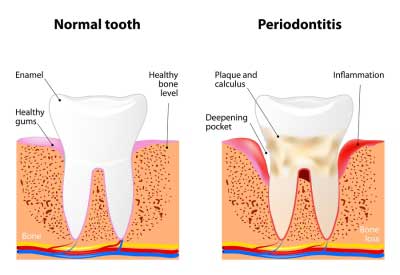The Stages of Gum Disease

A routine visit to the dentist’s office can leave some patients with unwelcome news, the presence of gum disease. The best way to stop gum disease before it reaches an advanced stage is by recognizing the early warning signs that your gums and teeth are unhealthy and need extra attention. If you are saddled with gum disease in Westlake, take a moment to better understand the three distinct stages of periodontal (gum) disease, so you can protect and improve your healthy smile.
Gingivitis
One of the earliest signs of gingivitis is bleeding when you brush and floss your teeth. This first stage of gum disease is caused by the buildup of plaque at the gum line, leading to the initial inflammation. When your regular brushing and flossing routine misses some plaque, it creates toxins that irritate the surrounding tissue. That leads to the tell-tale sign of bleeding. Patients with gingivitis are in luck, as damage at this stage of the disease is reversible. The bone and tissue attached to your teeth are not affected at this point.
Periodontitis
In this second stage, irreversible damage occurs to the fibers and bone that keep your teeth in place. When this happens, the gums pull away from teeth and create spaces. These pockets of space that begin to form just below the gum line create a trap for food and plaque. These spaces become infected, and the resulting bacterial toxins and your body’s response to the infection lead to a breakdown in the tissue and bone. You can prevent added damage by sticking to a proper regimen of brushing and flossing at home and seeking professional dental care.
Advanced Periodontitis
In this final stage of gum disease, the fibers and bone that surround your teeth fail and leave teeth unsupported, causing them to loosen or shift. Your bite could shift or worsen and your dentist might need to remove teeth that can’t be saved by aggressive treatment. Even at this late stage of the disease, changing personal habits can improve your chances of a positive outcome. Patients who quit smoking, for instance, have better odds of successful treatment.
